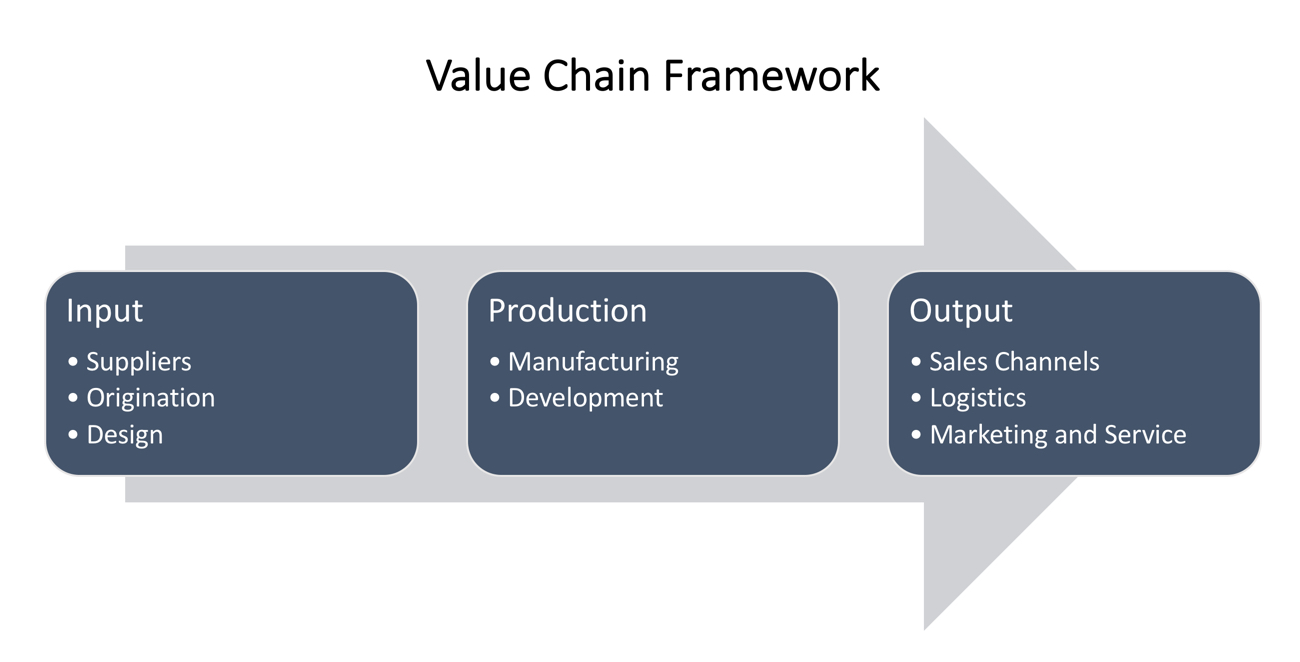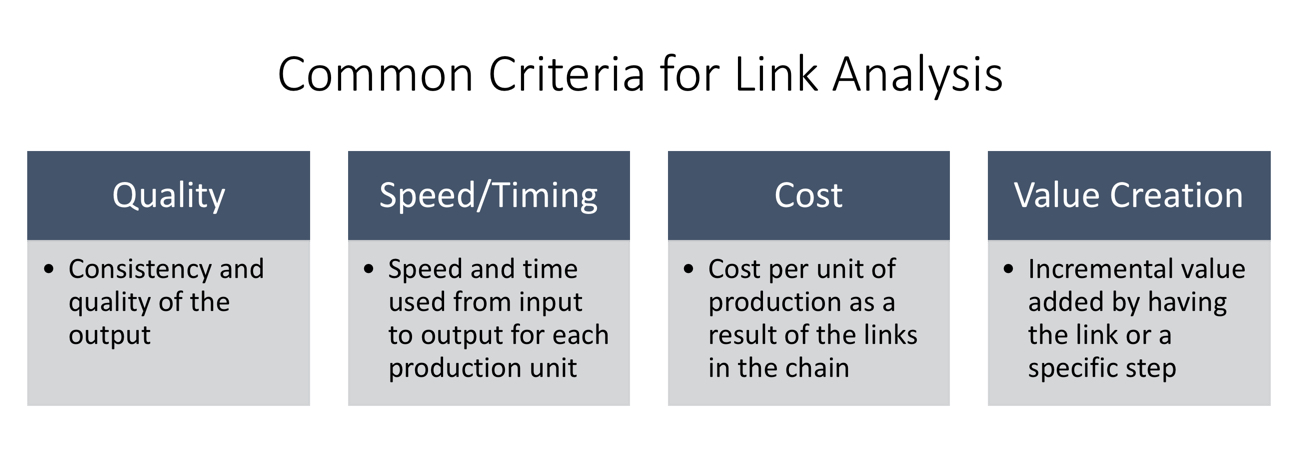Candidates often use the Value Chain Framework without being aware of it. It may form part of your thinking when breaking down a problem using a MECE tree diagram or used when drilling into upstream suppliers and downstream distributors. However, the Value Chain Framework is indeed very useful when it comes to breaking down a firm’s activities and processes, so it deserves our attention.
Fortunately, the structure of the Value Chain Framework is very easy to remember. There are three stages, and they follow in sequence: Input, Production, Output.
A key purpose of this framework is to analyse links between the activities of a company or industry that generate value for the end user. For example, a link between procurement and manufacturing, or manufacturing and marketing. So, what we really need to understand is how to examine these links. The way to analyse links in the value chain is to:
- Compare the same link in a value chain over time to identify trends,
- Identify and examine complementarity between one link and others in the same value chain, and
- Compare to the value chains of key competitors to identify opportunities for improvement.
Before we go into more details about linkages, let’s have a look at the body of the framework to understand what’s in each stage.
Stage 1 – Input
To begin the analysis, it is important to identify the inputs (otherwise known as “resources”, “raw materials” or “factors of production”). For different industries the inputs will be very different. However, candidates can normally think about three aspects.
- Supply: For many manufacturing cases, inputs are materials from suppliers. This can be further broken down into different types of materials needed to produce the finished product.
- Origination: The initial source of the material. For example, inputs in the mining industry are originally discovered through prospecting.
- Design: This is the formula and plan to produce a product or service. For example, one of Ikea’s more important inputs is the design of its furniture.
Stage 2 – Production
Production is all about turning inputs into useful output. The task here is to define all production processes. Production processes can be manufacturing for tangible products like cars, ships, houses, or food. Production can also involve activities that produce intangible products such as coding software, painting pictures, or writing reports.
Stage 3 – Output
The final stage is when the finished product or service is introduced to customers, sold, distributed, and serviced. Candidates may want to identify sales channels (such as online, wholesale, retail, or department store), and logistics (such as train, truck, shipping, or air freight). It is important to address how products and services are delivered to customers.
Link Analysis
The next part of this framework involves examining linkages between activities. The criteria are limitless in real life. However, there are 4 common criteria that can be applied to most cases (see a summary below). What candidates need to do is apply the criteria to all three stages, assess the links in the value chain to determine existing performance, missing links, and areas for improvement.
Case Prompts
Finally, I want to provide three case prompts for which you can use the Value Chain Framework.
Prompt I: “Company A has lost control of its costs. Increasing costs have dramatically impacted profit margins. CEO of Company A has asked you to identify the source of cost increases.” This prompt indicates that you should use the whole Value Chain Framework. Candidates may initially start with the Profit Framework but mainly focus on the cost part of that framework. When breaking down costs, candidates should quickly realize that the Value Chain Framework fits the analysis very well.
Prompt II: “Company B has significant challenges in its downstream value chain. Based on market research, the company knows that there is significant demand for its product, however few customers are buying. What is the root cause of the problem?” This prompt is an obvious one for using the Value Chain Framework. However, candidates should focus on the Output Stage since the main issue is sales and distribution.
Prompt III: “Company C has recalled a large number of products in the past few months, which almost bankrupted the company. The CEO wants you to find out how to prevent this issue from happening again and ensure the quality of the products.” This case prompt requires candidates to focus on the Input or probably Production part of the framework. And “quality” is the main criteria when assessing linkages in the chain.
A final caveat when using the Value Chain Framework is to be aware of the relevance of your criteria and area of focus in each stage. There are thousands of criteria and things to focus on in each stage. Please make sure you surface them by asking the interviewer probing questions rather than blindly following what I have told you in this article.
Free Download: This guidebook distils all of Mike’s insights on how to achieve success in your journey towards a career in management consulting: download now!
Mike Ni believes that technology is the engine of the future, while business capability is the wheel!
Image: Pexels


